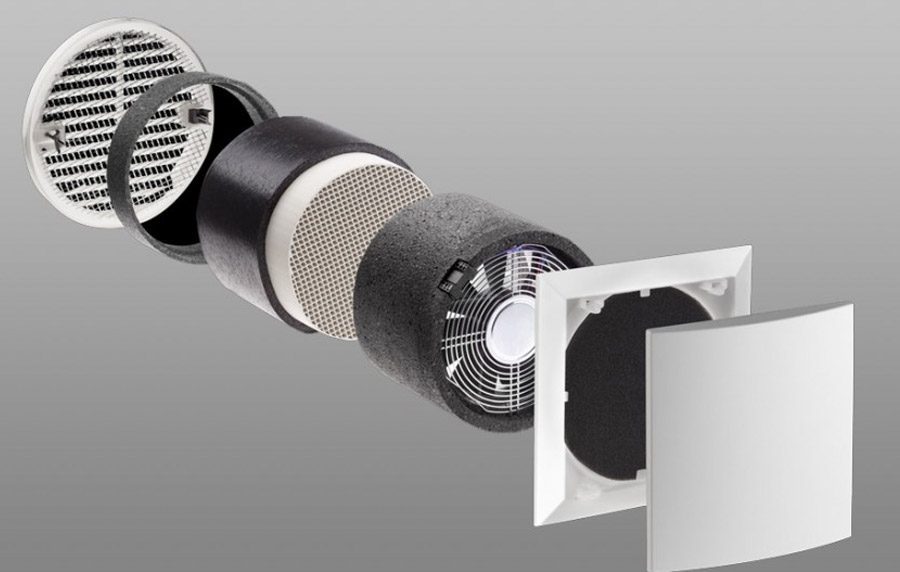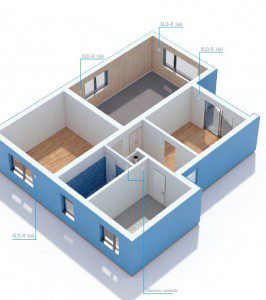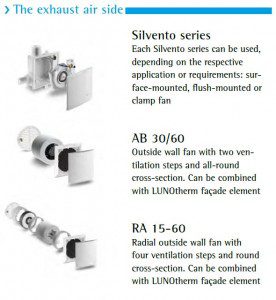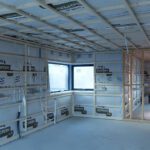Principles
LUNOS ventilation systems are based on air flow of the entire residential areas in line with specific needs. The decentralised fans of LUNOS can be combined into three different ventilation systems for efficient ventilation:
- Demand controlled systems (DCV)
- Systems with heat recovery
- Hybrid system
1. Demand Controlled Ventilation Systems – DCV
Fans discharge the exhaust air from the bathroom, WC or washroom externally or into exhaust air shafts in accordance with requirements and the level of humidity. This results in a slight under-pressure in the living area. As a result of this under-pressure, fresh, filtered air flows through the outside wall vents into the living room and bedroom, children’s room and the work rooms. Special attention is paid to moisture-regulated home ventilation. Using this system, approved by the building authorities, a considerable amount of loss of ventilation heat can be saved.
“Innovative Control: Humidity and Temperature”
- About Lunos DCV
Needs-driven regulation of the Silvento exhaust air fans has been fitted with a humidity-temperature sensor. This innovative regulation adjusts the fan speed automatically to the ventilation requirements: the air flow increases or decreases depending on the relative humidity. This ensures that as much ventilation is made as required and as little as possible. The sensor integrated in the suction section of the exhaust air fan records the temperature as well as the humidity content of the exhaust air flow. Since the fan is installed in the bathroom or WC where different room air conditions arise compared to the living room areas, the simultaneous evaluation of temperature and humidity ensures ventilation (step 1 to 4) adjusted to the room air conditions in the living room areas. Therefore, this control not only considers the requirements in the bathroom, but also the needs in the living room area and provides effective protection against moisture damage and mould formation. The automatic seasonal time switch adjusts the fan automatically to the lowest stage in summer and back to humidity control in the transition period and winter season.

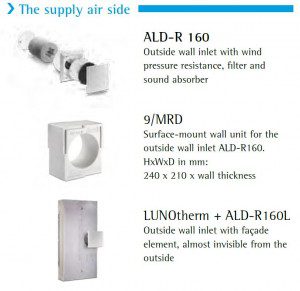
2. Systems with Heat Recovery
All living room areas are equipped with heat recovery units in this extremely efficient system. The new ego also enables ventilation of classical exhaust air rooms using this device. Living room areas are equipped with the well-proven e2. This system can save €6-10,000 when compared to centralised systems.
- The e² and ego principle in ventilation systems with heat recovery
Via the ego, the e2 can be used to optimum effect in a ventilation system with heat recovery. On account of the decentralised concept, the individual fans can be installed exactly where they are required. e2 fans are used in living room areas, and two units are always in operation as pairs. Therefore, an even number of units must always be installed to ensure the units work properly. Functional rooms such as bathrooms and kitchens are ventilated via the ego. Operation in pairs is not required, since two ‘small’ e2 in the ego ensure supply and exhaust air with heat recovery.
- Ventilation in living rooms is applied as in bedrooms, with e²:
The e2 operates in accordance with the principle of the regenerative heat exchanger. A storage element charges in a similar way to a battery with heat energy in reversing operation and transfers the heat to the outside air supplied. The fan with heat recovery has a power consumption of just 1.4 Watts in base load operation (0.09 W/m3/h) – costing from 1.50 per annum to run one e2
- Ventilation in the bathroom, WC and kitchen with ego:
The ego also operates in accordance with the principle of the regenerative heat exchanger. A storage element charges with heat as in the well-known e2. However, this is distributed skilfully with two fans so that supply and exhaust air are provided simultaneously. A second device is not required for operation. The system can also be switched to exhaust air mode in which a very high flow of 45 m3/h is discharged in order to enable fresh air to flow into the room quickly (e.g. WC or bathroom). 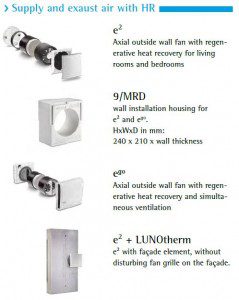
3. Hybrid Systems
Hybrid ventilation systems are combinations of at least two different types of ventilation. Combination of exhaust air devices and fans with heat recovery are especially effective. The benefits of such hybrid combinations are clear: while living areas are equipped with heat recovery devices, the more favourably priced exhaust air device can be used in classical exhaust air rooms such as the bathroom, WC or kitchen which are only used when required.
- Combining with different Systems
The 160 modular system makes it easier to plan and implement hybrid ventilation. If the Silvento series does not have to be included in planning, you can use the same installation tube for each ventilation unit of your building project. The exhaust air series Silvento is used for bathrooms and kitchens without windows in apartment buildings. The benefits of the hybrid combination are clear: while living room areas are equipped with the heat recovery device e2, a lower priced exhaust air device can be used in classical exhaust air rooms such as the bathroom, WC or kitchen which is only used when needed.
- The e² Principle
LUNOS ventilation systems with heat recovery can be used everywhere. As a result of the decentralized concept, the individual fans can be installed where they are required. The fans of the e2 series operate in accordance with the well-known principle of regenerative heat exchange which has been practically perfected by the LUNOS Company. Combination with classical exhaust air systems provides a convincing benefit in terms of cost and use.
- The exhaust air fans of the 160 series
With its new products AB/30 and RA 15-60, LUNOS provides an ideal enhancement to the 160 series in classical exhaust air rooms subjected to humidity, such as the bathroom, WC and the kitchen. With the aesthetic dreams of house and apartment owners in mind, engineers at LUNOS also focused on the design when developing the new fans. These fans present themselves like their ‘big brother’ e2: inside panel, filter and outside grille are from the same product family, whereby the RA 15-60 is more pressure-resistant than its alternative, the AB 30/60.

